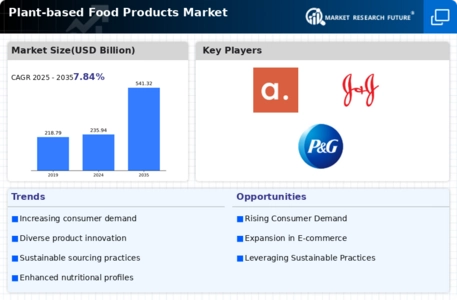The Plant-based Food Products Market is currently characterized by a dynamic competitive landscape, driven by increasing consumer demand for sustainable and health-conscious food options. Key players such as Beyond Meat (US), Impossible Foods (US), and Oatly (SE) are at the forefront, each adopting distinct strategies to enhance their market presence. Beyond Meat (US) focuses on innovation, particularly in developing new product lines that cater to diverse dietary preferences, while Impossible Foods (US) emphasizes partnerships with major food service providers to expand its reach. Oatly (SE), on the other hand, is leveraging its strong brand identity in the dairy alternative segment, aiming to capture a larger share of the market through strategic marketing initiatives and product diversification. Collectively, these strategies contribute to a competitive environment that is increasingly centered around innovation and consumer engagement.
In terms of business tactics, companies are increasingly localizing manufacturing to reduce supply chain vulnerabilities and enhance product freshness. This approach appears to be particularly relevant in a moderately fragmented market structure, where the collective influence of key players shapes consumer choices and market dynamics. The emphasis on supply chain optimization is evident as companies strive to improve efficiency and sustainability, which is becoming a critical factor in consumer purchasing decisions.
In September 2025, Beyond Meat (US) announced a partnership with a leading fast-food chain to introduce a new line of plant-based burgers, aiming to capture the growing demand for convenient, on-the-go meal options. This strategic move not only enhances Beyond Meat's visibility but also aligns with the increasing trend of plant-based diets among younger consumers. The collaboration is expected to significantly boost sales and brand recognition in a competitive fast-food landscape.
In August 2025, Impossible Foods (US) launched a new product line featuring plant-based seafood alternatives, marking a significant expansion into a previously untapped market segment. This strategic diversification is indicative of the company's commitment to innovation and reflects a broader trend within the industry towards offering a wider variety of plant-based options. By entering the seafood market, Impossible Foods (US) positions itself to attract a new customer base while addressing the growing consumer interest in sustainable seafood alternatives.
In July 2025, Oatly (SE) unveiled a new sustainability initiative aimed at reducing its carbon footprint across its supply chain. This initiative includes investments in renewable energy sources and sustainable packaging solutions, which are increasingly important to environmentally conscious consumers. Oatly's proactive approach not only enhances its brand reputation but also aligns with the industry's shift towards sustainability as a core business strategy.
As of October 2025, the competitive trends within the Plant-based Food Products Market are increasingly defined by digitalization, sustainability, and the integration of advanced technologies such as AI in product development and supply chain management. Strategic alliances are becoming more prevalent, as companies recognize the value of collaboration in enhancing innovation and market reach. Looking ahead, competitive differentiation is likely to evolve from traditional price-based competition to a focus on innovation, technological advancements, and supply chain reliability, reflecting the changing preferences of consumers who prioritize quality and sustainability.

















Leave a Comment